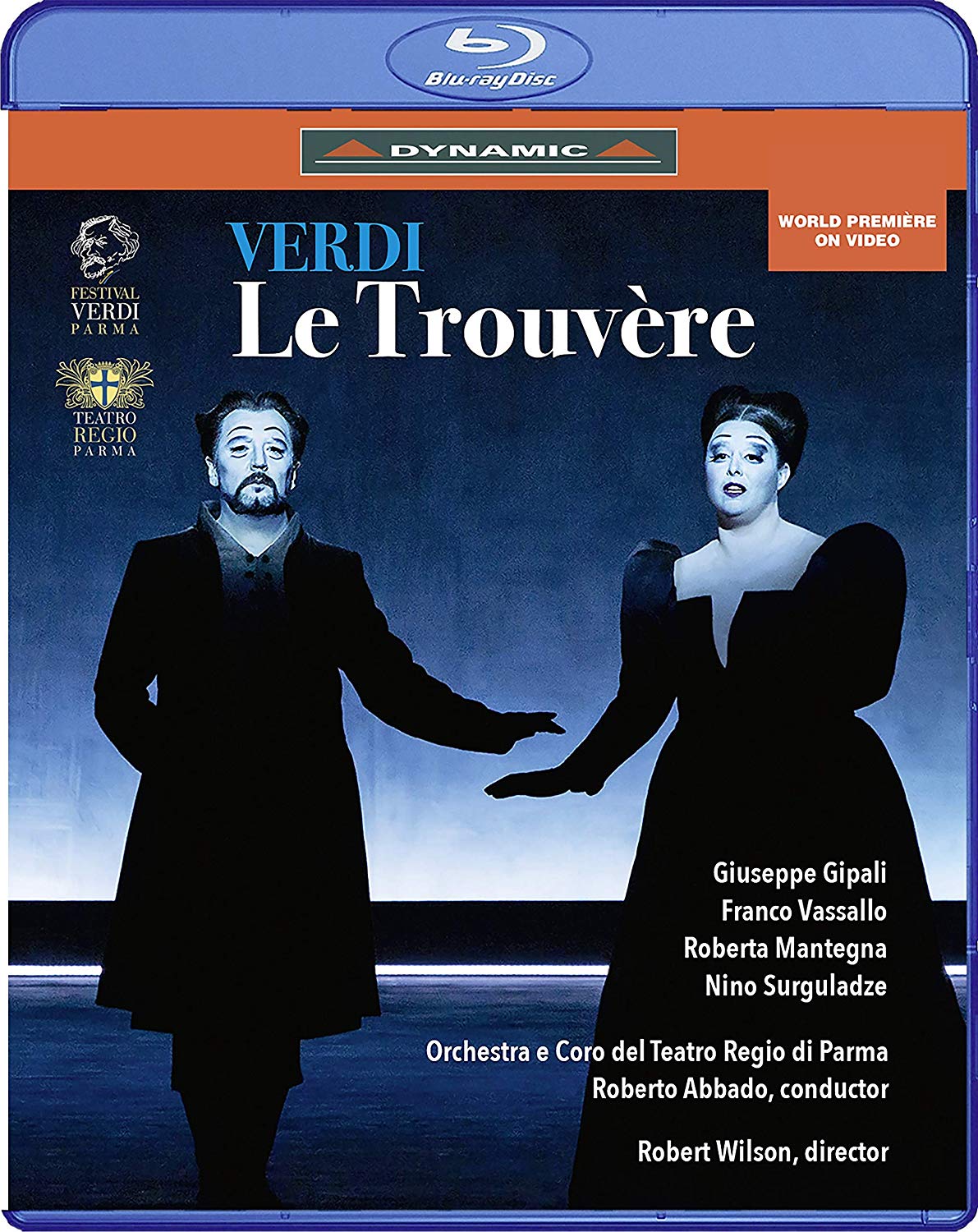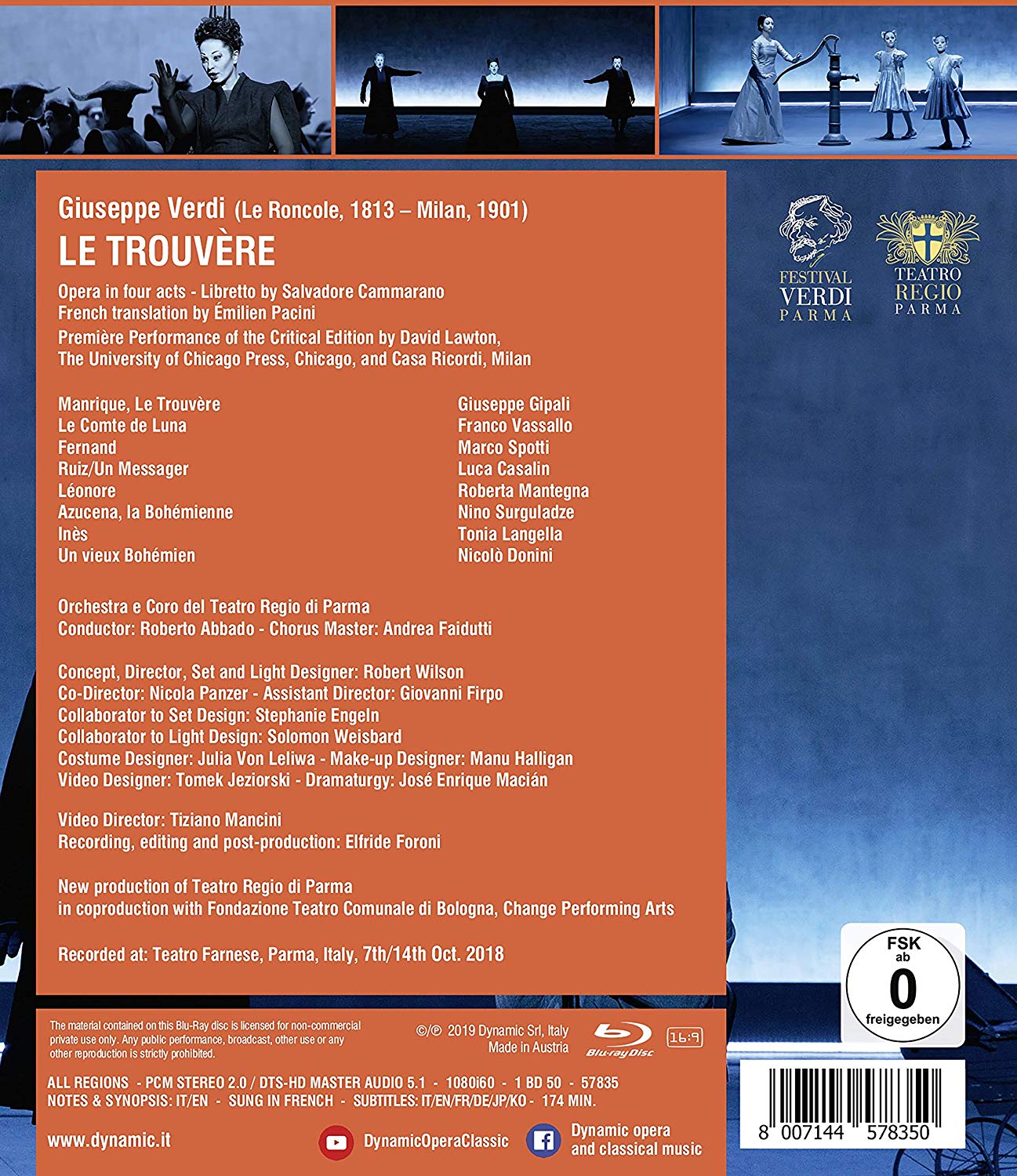

Verdi Le Trouvère (Il trovatore in the original Italian) opera to libretto by Salvadore Cammarano and Leone Emanuele Bardare and translated into French by Emilien Pacini. Directed 2018 by Robert Wilson at the Teatro Farnese, Parma, Italy (Co-Director Nicola Panzer; Assistant Director Giovanni Firpo). Stars Giuseppe Gipali (Manrique, Le Trouvère), Franco Vassallo (Le Comte de Luna), Marco Spotti (Fernand), Luca Casalin (Ruiz / Un Messager), Roberta Mantegna (Léonore), Nino Surguladze (Azucena, la Bohémienne), Tonia Langella (Inès), and Nicolo Donini (Un vieux Bohémien). Roberto Abbado conducts the Orchestra e Coro del Teatro Regio di Parma (Chorus Master Andrea Faidutti). Concept, set, and lighting design by Robert Wilson; collaborator for set design was Stephanie Engeln; collaborator for lighting design was Solomon Weisbard; costume design by Julia Von Lellwa; make-up design by Manu Halligan; video designs by Tomek Jeziorski; dramaturgy by José Enrique Macián. Directed for TV by Tiziano Mancini. Sung in French. Released 2019, disc has 5.1 dts-HD Master Audio sound. Grade: NA
This is the French version of Il trovatore that Verdi modified in many ways from the Italian version. The Parma Verdi Festival has a mission of presenting less frequently performed versions of Verdi’s works. In addition to the alternate language, there are other unusual aspects of this performance.
We start with a word about the amazing venue of Teatro Farnese with its horseshoe shaped seating and exposed wooden beam roof:
For this Le Trouvère the Festival removed the ramp and placed temporary seating on the floor facing the modest stage. The permanent arena-style seating was not used. There was no pit for the orchestra. The large empty space resulted in troublesome reverberation of sound that had to be adjusted for. The ancient building is not equipped for modern opera productions, but the static nature of Robert Wilson’s set allowed him to cope this primitive stage. It must have been a creepy experience for the audience to see Wilson’s typical surreal and hallucinatory show in this relic of long-ago centuries.
Wilson is at his best when he creates something completely new. He jump-started his career when he wrote the story boards for and directed the cult classic Einstein on the Beach, which brought world-wide fame to himself and Philip Glass. More recently Wilson created Adam’s Passion which was inspired by music from Arvo Pärt. We gave A+ grades to our HDVDs of both of these works. But most of Wilson’s work is as stage director for existing masterpieces like the HDVD of L’Orfeo that we graded B+.
I found Wilson’s L’Orfeo—full of surprises and brightly lit—enjoyable for it’s duration of 2 hours. But would 3 hours of Verdi be a bridge too far to reach with Robert? In the January 2020 Gramophone at page 90, Neil Fisher writes:
“Wilson’s staging doesn’t so much present a piece as float above it. The characters are not there to enact the drama; instead they appear to represent it. The whole harmonious vision is more important than narrative flow. This collision of an unfamiliar version of a classic opera, in a language you don’t expect to hear, alongside Wilson’s abstraction reinforces the overall dislocation. The result is strangely compelling.”
Here’s a trailer from Dynamic:
This Robert Wilson production was a joint effort of the Teatro Comunale di Bologna, which produced Il trovatore in Italian in 2018, and the Parma Verdi Festival, which produced the French Le Trouvère in 2019. The two productions have mostly different casts and production workers, but it’s a good bet that the versions are very similar as far as Robert Wilson’s mise-en-scène is concerned. The Italian version was recorded for streaming; the French version was recorded to be published in video. So to get a better idea about the Wilson’s designs, you can check out the entire Italian-language opera in the YouTube clip below! The Dynamic Blu-ray disc in French will likely have significantly better PQ, SQ, as well as more up-to-date subtitles, etc. than the Italian version.
Life is full of mysteries. The original Italian version had no ballet scene. But the French Grand Opera version has a ballet scene because that’s what the French audience expected. Wilson puts his ballet, I think, in both the French and Italian shows discussed here. But Wilson doesn’t go for girls on point—he stages men, women, and children as identically-dressed boxers working out at the gym with big red sparring gloves! For more of Wilson boxing artists, check out the depiction of Cain and Abel in the screenshots we have of Adam’s Passion. Once Wilson invents a neat image, he likes to repeat it!
OR


